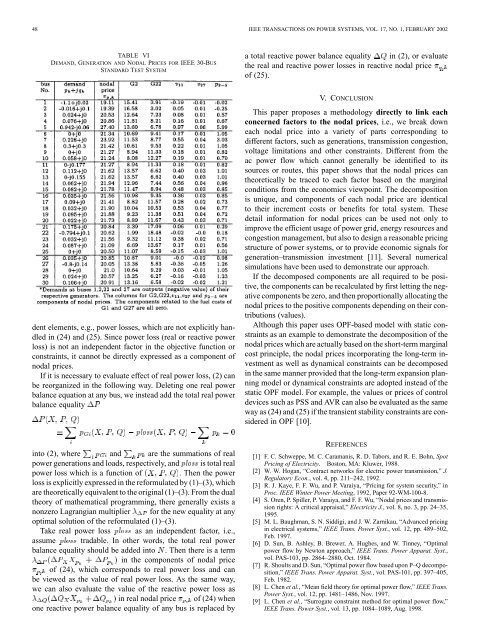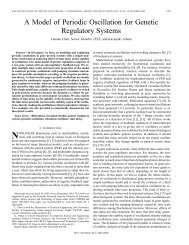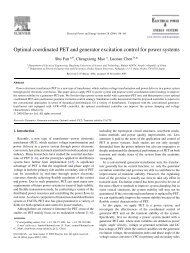Components of nodal prices for electric power systems - Power ...
Components of nodal prices for electric power systems - Power ...
Components of nodal prices for electric power systems - Power ...
You also want an ePaper? Increase the reach of your titles
YUMPU automatically turns print PDFs into web optimized ePapers that Google loves.
48 IEEE TRANSACTIONS ON POWER SYSTEMS, VOL. 17, NO. 1, FEBRUARY 2002TABLE VIDEMAND, GENERATION AND NODAL PRICES FOR IEEE 30-BUSSTANDARD TEST SYSTEMa total reactive <strong>power</strong> balance equality in (2), or evaluatethe real and reactive <strong>power</strong> losses in reactive <strong>nodal</strong> price<strong>of</strong> (25).dent elements, e.g., <strong>power</strong> losses, which are not explicitly handledin (24) and (25). Since <strong>power</strong> loss (real or reactive <strong>power</strong>loss) is not an independent factor in the objective function orconstraints, it cannot be directly expressed as a component <strong>of</strong><strong>nodal</strong> <strong>prices</strong>.If it is necessary to evaluate effect <strong>of</strong> real <strong>power</strong> loss, (2) canbe reorganized in the following way. Deleting one real <strong>power</strong>balance equation at any bus, we instead add the total real <strong>power</strong>balance equalityV. CONCLUSIONThis paper proposes a methodology directly to link eachconcerned factors to the <strong>nodal</strong> <strong>prices</strong>, i.e., we break downeach <strong>nodal</strong> price into a variety <strong>of</strong> parts corresponding todifferent factors, such as generations, transmission congestion,voltage limitations and other constraints. Different from theac <strong>power</strong> flow which cannot generally be identified to itssources or routes, this paper shows that the <strong>nodal</strong> <strong>prices</strong> cantheoretically be traced to each factor based on the marginalconditions from the economics viewpoint. The decompositionis unique, and components <strong>of</strong> each <strong>nodal</strong> price are identicalto their increment costs or benefits <strong>for</strong> total system. Thesedetail in<strong>for</strong>mation <strong>for</strong> <strong>nodal</strong> <strong>prices</strong> can be used not only toimprove the efficient usage <strong>of</strong> <strong>power</strong> grid, energy resources andcongestion management, but also to design a reasonable pricingstructure <strong>of</strong> <strong>power</strong> <strong>systems</strong>, or to provide economic signals <strong>for</strong>generation–transmission investment [11]. Several numericalsimulations have been used to demonstrate our approach.If the decomposed components are all required to be positive,the components can be recalculated by first letting the negativecomponents be zero, and then proportionally allocating the<strong>nodal</strong> <strong>prices</strong> to the positive components depending on their contributions(values).Although this paper uses OPF-based model with static constraintsas an example to demonstrate the decomposition <strong>of</strong> the<strong>nodal</strong> <strong>prices</strong> which are actually based on the short-term marginalcost principle, the <strong>nodal</strong> <strong>prices</strong> incorporating the long-term investmentas well as dynamical constraints can be decomposedin the same manner provided that the long-term expansion planningmodel or dynamical constraints are adopted instead <strong>of</strong> thestatic OPF model. For example, the values or <strong>prices</strong> <strong>of</strong> controldevices such as PSS and AVR can also be evaluated as the sameway as (24) and (25) if the transient stability constraints are consideredin OPF [10].plossinto (2), where and are the summations <strong>of</strong> real<strong>power</strong> generations and loads, respectively, and ploss is total real<strong>power</strong> loss which is a function <strong>of</strong> . Then the <strong>power</strong>loss is explicitly expressed in the re<strong>for</strong>mulated by (1)–(3), whichare theoretically equivalent to the original (1)–(3). From the dualtheory <strong>of</strong> mathematical programming, there generally exists anonzero Lagrangian multiplier <strong>for</strong> the new equality at anyoptimal solution <strong>of</strong> the re<strong>for</strong>mulated (1)–(3).Take real <strong>power</strong> loss ploss as an independent factor, i.e.,assume ploss tradable. In other words, the total real <strong>power</strong>balance equality should be added into . Then there is a termin the components <strong>of</strong> <strong>nodal</strong> price<strong>of</strong> (24), which corresponds to real <strong>power</strong> loss and canbe viewed as the value <strong>of</strong> real <strong>power</strong> loss. As the same way,we can also evaluate the value <strong>of</strong> the reactive <strong>power</strong> loss asin real <strong>nodal</strong> price <strong>of</strong> (24) whenone reactive <strong>power</strong> balance equality <strong>of</strong> any bus is replaced byREFERENCES[1] F. C. Schweppe, M. C. Caramanis, R. D. Tabors, and R. E. Bohn, SpotPricing <strong>of</strong> Electricity. Boston, MA: Kluwer, 1988.[2] W. W. Hogan, “Contract networks <strong>for</strong> <strong>electric</strong> <strong>power</strong> transmission,” J.Regulatory Econ., vol. 4, pp. 211–242, 1992.[3] R. J. Kaye, F. F. Wu, and P. Varaiya, “Pricing <strong>for</strong> system security,” inProc. IEEE Winter <strong>Power</strong> Meeting, 1992, Paper 92-WM-100-8.[4] S. Oren, P. Spiller, P. Varaiya, and F. F. Wu, “Nodal <strong>prices</strong> and transmissionrights: A critical appraisal,” Electricity J., vol. 8, no. 3, pp. 24–35,1995.[5] M. L. Baughman, S. N. Siddigi, and J. W. Zarnikau, “Advanced pricingin <strong>electric</strong>al <strong>systems</strong>,” IEEE Trans. <strong>Power</strong> Syst., vol. 12, pp. 489–502,Feb. 1997.[6] D. Sun, B. Ashley, B. Brewer, A. Hughes, and W. Tinney, “Optimal<strong>power</strong> flow by Newton approach,” IEEE Trans. <strong>Power</strong> Apparat. Syst.,vol. PAS-103, pp. 2864–2880, Oct. 1984.[7] R. Shoults and D. Sun, “Optimal <strong>power</strong> flow based upon P–Q decomposition,”IEEE Trans. <strong>Power</strong> Apparat. Syst., vol. PAS-101, pp. 397–405,Feb. 1982.[8] L. Chen et al., “Mean field theory <strong>for</strong> optimal <strong>power</strong> flow,” IEEE Trans.<strong>Power</strong> Syst., vol. 12, pp. 1481–1486, Nov. 1997.[9] L. Chen et al., “Surrogate constraint method <strong>for</strong> optimal <strong>power</strong> flow,”IEEE Trans. <strong>Power</strong> Syst., vol. 13, pp. 1084–1089, Aug. 1998.






